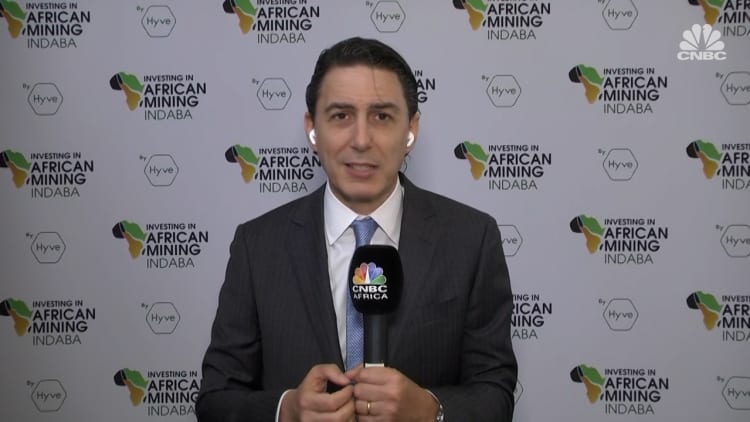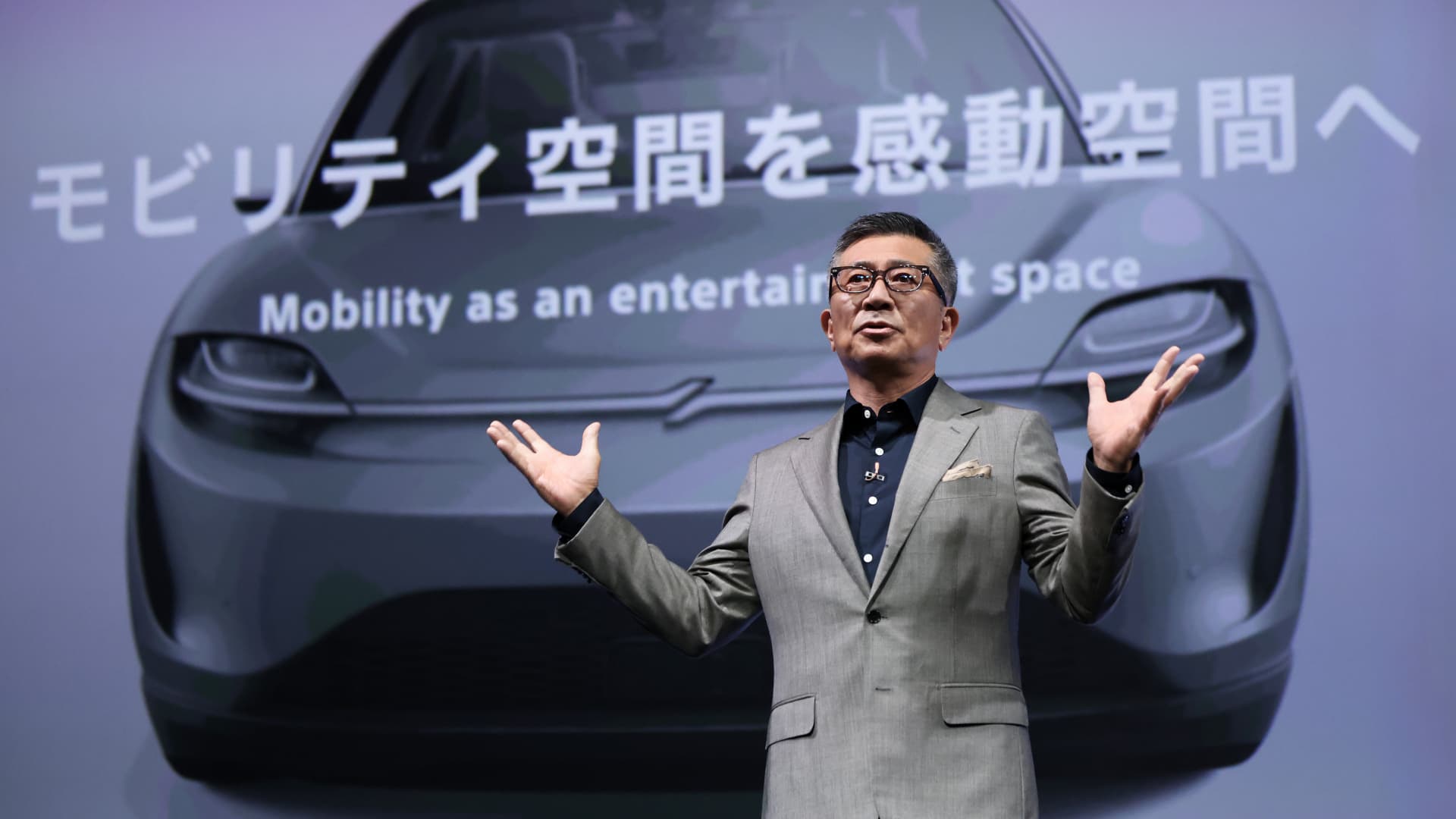Sony Honda Mobility CEO Yasuhide Mizuno speaks at a news conference in Tokyo, on Oct. 13, 2022. Sony and Honda’s joint mobility venture unveiled a new EV prototype in January.
Kiyoshi Ota | Bloomberg | Getty Images
Japan is gearing up to be a larger player in the EV space by signing a critical minerals trade deal with the U.S., but it has a lot of catching up to do and resource restraints could slow its progress.
Tokyo in March signed the U.S.-Japan Critical Minerals Agreement, securing both countries’ commitment to strengthen supply chains and promote EV battery technologies.
Notably, the deal allows minerals from Japan to meet sourcing requirements for U.S. electric vehicle tax credits, unlocking up to $7,500 per vehicle. The U.S. signed the Inflation Reduction Act in 2022, which subsidizes the domestic production of electric vehicles and batteries.
The critical minerals agreement was “negotiated in warp-speed time” when similar deals “usually take years,” David Boling, Eurasia Group director for Japan and Asian trade, told CNBC.
Japan urgently desires to meet these requirements, but “Japanese auto firms have a lot of catching up to do on electric vehicles, if they want to be major players,” said Boling, who previously served as a trade negotiator for the Office of the U.S. Trade Representative, working on Japan-related deals.
Playing catch-up
Japan has lagged behind in electric vehicles. While Western and Chinese automakers controlled approximately 90% of the global EV market in 2022, their Japanese peers accounted for less than 5%, Nikkei Asia reported.
But the country’s automakers like Toyota have been making moves to close that gap. New CEO Sato Koji announced at his first press conference that Toyota plans to release 10 new battery electric vehicle models amounting to 1.5 million in annual sales by 2026.
That’s a marked shift from just last September, when his predecessor Akio Toyoda said the automaker would continue investing in a variety of electrified vehicles — rather than going all-in on all-electric or battery electric vehicles. His remarks essentially doubled down on Toyota’s EV strategy at the time, which some investors and environmentalist groups had criticized as being too conservative.
Sato replaced Toyoda as CEO in April with the aim of “accelerating [Toyota’s] shift to electrification,” according to an official transcript. Toyoda now serves as the company’s chairman.
Honda also announced in April plans to produce more than 2 million EVs annually by 2030, with an ultimate goal of selling only BEVs or hydrogen-powered EVs globally by 2040.
Up until now, Japanese automakers have focused more on hybrids and hydrogen, said Eurasia’s Boling. Similar to Toyota, automakers like Honda and Nissan only recently announced significant expansions of their all-electric vehicle lineups. Hybrid EVs still account for 96.8% of new EV sales in the country, according to the Japan Automobile Dealers Association.
But BEVs are the main drivers of growth for the number of EVs on roads worldwide, accounting for over 70% of total annual growth in 2022, the International Energy Agency reported. Just over 730,000 BEVs were sold in the U.S. in 2022, representing 43.5% of all EV sales that year, data from Argonne National Laboratory showed.
BEV sales are also growing rapidly in China, increasing by 60% relative to 2021 to reach 4.4 million, the IEA added. The world’s largest EV market has implemented a wide array of EV promotion policies in its major cities, the IEA said, such as subsidies for each purchase of a pure EV.
“Japanese firms were slow out of the starting blocks and may not be able to compete now in this EV mad dash,” Boling said.
EV supply chain strain
Japan depends on China for critical minerals essential to the production of EV components. Over 90% of EVs marketed today contain permanent-magnet synchronous motors, which use rare earth elements that are geographically concentrated in China, according to the International Energy Agency.
China refines 90% of these elements as well as 60% to 70% of lithium and cobalt, which are needed to make EV batteries, an IEA report found. Japan is the largest consumer of rare earth elements, such as dysprosium, outside of China.
“I don’t see any short- or medium-term future where China’s not the key global player in the supply chain,” said Kristin Vekasi, a political science associate professor at the University of Maine.

As part of efforts to diversify away from China in its EV supply network, Japan’s government and top manufacturers are pursuing new technologies to reduce reliance on China-sourced materials.
Proterial, previously known as Hitachi Metals, is working to develop EV motors that use fewer rare earth metals, Nikkei Asia reported. In 2022, the Japanese government also allocated 6 billion yen ($42.9 million) toward a project that explores extracting rare earths from deep sea mud, Nikkei Asia reported.
But finding alternatives to current rare earth sources will take a lot of time and money, said Boling. “In the meantime, Japan must come to grips with its dependency on China and do all it can to mitigate that risk,” he said.
Developing economic relations
For now, Japan has emphasized economic cooperation as a counterweight to its dependence on China’s EV supply chains. A top government official said Japan will promote critical mineral resources development with the G-7 and other “like-minded countries,” reported S&P Global Commodity Insights.
Japan’s Prime Minister Fumio Kishida has focused on Southeast Asia as a part of his foreign policy strategy, inviting Singapore to an outreach meeting of G-7 finance leaders as well as inviting Indonesia to join the G-7 meetings in Hiroshima.
Boling, the former trade negotiator, said the latter “stands out” as “a sign of Japan’s aim to develop stronger economic relations with Indonesia across many fronts, including critical minerals.” Indonesia has one of largest nickel reserves in the world and is expected to contribute 46% of global primary nickel production by 2027, reported S&P Global Commodity Insights. Nickel is a critical component in the lithium-ion battery cells most EVs use.
The government will also continue to provide direct funding for Japan-led projects, as state agencies like the Ministry of Economy, Trade and Industry or the Japan Organization for Metals and Energy Security have historically done. METI will subsidize up to half the cost of smelting and mine development projects by Japanese companies, Nikkei Asia reported in April.
In a sector where “success rates are low,” “state intervention is necessary at least in the short term,” said Vekasi.
Government assistance and investment can mitigate risks like the “long time horizon” of mining projects, price volatility of minerals and lack of expertise in junior mining companies, Vekasi added.
Japan’s EV hopes were the “catalyst” for the critical minerals trade agreement with the U.S., said Boling. It remains to be seen whether recent initiatives from automakers and state agencies will realize those ambitions.
